(Click on any of the images for a larger view.)
All those New Year’s resolutions (lose weight, be healthier, etc.) can be rolled up into one: Eat good food! Bet you thought that you would have to eliminate meat from your diet! Nope, if you choose to have meat as part of your diet, just eat a reasonable amount and make sure it has been raised responsibly and fed an appropriate diet. “Meatless Mondays,” flexitarian, vegetarian – it all works when you serve good food.
Meet Your Meat
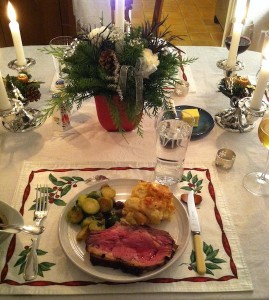 While imagining that the beef they will be eating came from a cow living a happy-go-lucky life, frolicking on lush green pastures until a gentle and painless end, the average American does NOT want to meet their dinner while it is still standing.
While imagining that the beef they will be eating came from a cow living a happy-go-lucky life, frolicking on lush green pastures until a gentle and painless end, the average American does NOT want to meet their dinner while it is still standing.
However, the idea that you could if you wanted, or at least you could meet the farmer who raised your dinner, is not so far fetched. Buying beef raised by growers like Crown S Ranch in Winthrop WA means you can indeed track your meat back to the farm and to the cow itself.
We serve only Crown S Ranch‘s beef. We met the farmer, walked the pastures, and – very likely – came eye-to-eye with the cow that came to dinner. And while many will tell you it’s not possible to get a nicely marbled piece of meat from a cow that eats only grass, we show you that’s not the case! Crown S meat clearly has the fat required of a rib roast. What gives?
Where’s the Beef … From?
In one of the early episodes of Portlandia (Is it local?), Carrie and Fred discuss in detail the origin of the chicken they are offered for dinner. Colin (the prospective entré) has a bound CV to document his birthplace. While a book that weighs more than the chicken in question makes for good satire, how DO we learn more about the origins and sources of the meat on our plates? Colin may have had references, but very few of the animals slaughtered for your dinner get such recognition.
There are simply no good ways to track a single chicken, pig, or cow from farm to plate. Walk into any conventional big name supermarket and you’ll find miles of plastic-wrapped Styrofoam trays full of bright red steaks, roasts, and ground beef. You’re not likely to see any labels identifying where it was born and raised.
Why Not?
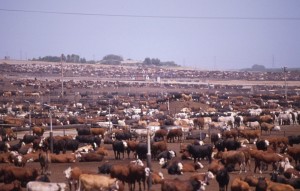
Over the last 70 years, the beef industry has evolved into an intense, industrial enterprise designed to put as much weight on animals as fast as possible and get the resulting meat to market as quickly as possible.
Agnes the Angus is nothing more than a meat factory packed cheek to jowl into feedlots and she/he is fed grain – lots of grain, most of which is genetically engineered – and antibiotics, hormones, and steroids to bring him/her up to the target weight for slaughter in less than a year.
In 2011, more than 34 million beef cattle were slaughtered, producing more than 26 billion pounds of meat. Just four companies control 84% of the beef packed for sale in the US. In some slaughterhouses (the old-fashioned name for “meat processing plants”), a single pound of ground beef could contain meat from dozens if not hundreds of animals.
Consideration for the animals and the consumers who eat them has been overtaken by the drive for profit. In response to the damaging impact of feedlot production, more and more farmers and ranchers are choosing to return to, and improve upon, traditional methods of raising cattle on grass.
Better for the Animals
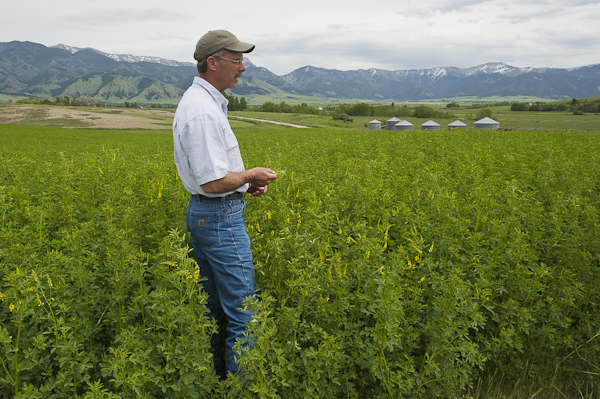
Beef cattle are ruminants; that is, they have multiple stomachs. They are able to digest plant cellulose by regurgitating the semi-digested plants and chewing them again to break the matter down further. The roughage provided by grasses and other plants allows ruminants to produce saliva, which helps neutralize acids that exist naturally in their digestive systems.
When taken off forage and put on a diet of grain and other byproducts – many of which should never cross the lips of a cow – the animal produces less saliva, causing an increase in acidity within its digestive tract. In response to the acidosis, cattle will kick at their bellies, stop eating feed and eat dirt. To treat the problem, they are often given plastic feed pellets for roughage, along with lots of chemicals, additives, and antibiotics.
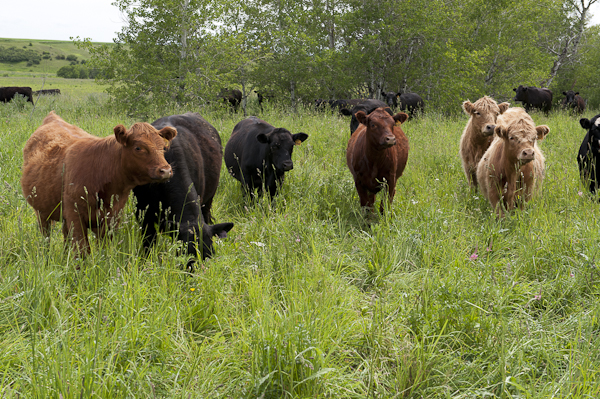
Grain-fed cattle often suffer from a number of health problems including intestinal damage, dehydration, liver abscesses, respiratory and cardiovascular failure, and death. There are estimates that as high as one-third of all feedlot cattle develop liver abscesses.
The high prices of corn and soybeans that resulted from last year’s massive drought throughout the Midwest and southwestern Great Plains sent cattlemen searching for something cheaper – but just as high calorie – to feed their cows. The solution? Candy! That’s right, candy. Cows are being fed chocolate bars, gummy worms, ice cream sprinkles, marshmallows, bits of hard candy and even powdered hot chocolate mix. All without any “apparent” harmful effects on the cattle or the consumers.
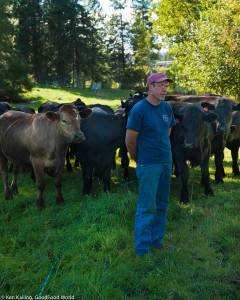
Combining rotational grazing and using elements of traditional animal husbandry has made it possible for Louis Sukovaty, co-owner of Crown S Ranch, to raise healthy cattle using organic processes that produce delicious meat entirely on grass and hay, the way cows are supposed to be fed. No grain, no hormones, no antibiotics… (Louis talks about the Grazing Eco-System here.)
(Take a virtual tour of Crown S Ranch here.)
For example, Louis has eliminated the need to use antibiotics to treat his cattle for pink eye and hoof rot, ailments that are common in cattle. For generations, farmers in the Methow Valley in north central Washington assumed that the diseases were contagious because so many cattle got them. As a result, when a cow was diagnosed with either or both, the farmer gave the whole herd antibiotics to prevent the spread. It turns out that the cause is bacteria that grow in the soil and, while the diseases are not contagious, every animal in the heard can get them.
Louis’ research uncovered a solution in a 1905 study conducted by Washington State University that indicated the bacteria grow in soils deficient in copper, like those of the Methow Valley. Conventional farmers will use antibiotics as a preventative; Louis simply adds traces of copper to a salt lick and the cattle stay healthy by ingesting the copper they need.
Grass-fed Goodness: Better for You
Americans eat more meat than ever before, and most of it is high in saturated fats. Researchers have linked serious health problems such as heart disease, stroke, diabetes, and certain types of cancer to heavy meat consumption. One way to avoid all those saturated fats? Grass-fed meat…
According to a study published in the Journal of Animal Science in 2002, and confirmed in a new study published this year in Nutrition Journal, eating grass-fed beef provides a long list of benefits to consumers, not just lower fat. Pastured meat is:
Lower in total fat
Lower in the saturated fats linked with heart disease
Higher in beta-carotene
Higher in vitamin E (alpha-tocopherol)
Higher in the B-vitamins thiamin and riboflavin
Higher in the minerals calcium, magnesium, and potassium
Higher in total omega-3s
Healthier ratio of omega-6 to omega-3 fatty acids
Higher in CLA (cis-9 trans-11), a potential cancer fighter
Higher in vaccenic acid (which can be transformed into CLA)
Lower Fat – Meat from grass-fed cattle is much lower in fat, and therefore lower in calories. A 6-ounce steak from a grass-fed animal has almost 100 fewer calories than the same sized-piece from a grain-fed animal. The average American eats about 67 pounds of beef a year. Switch to grass-fed beef and you’ll save nearly 18,000 calories a year.
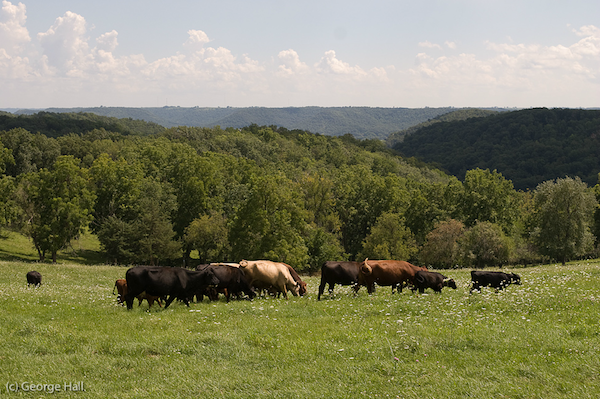
Omega-3 Fatty Acids – Omega-3 fatty acids are fats that are essential to human health. Sixty percent of the fatty acids in grass is omega-3, which is formed in the chloroplasts of green leaves. Meat from grass-fed cattle can contain as much as two-to-four times more omega-3 fatty acids than grain-fed animals.
At the same time, a high ratio of omega-6 to omega-3 fatty acids has been linked with an increased risk of cancer, cardiovascular disease, allergies, depression, obesity, and autoimmune disorders. A ratio of four to one or lower is considered ideal, grain-fed beef has a much higher ratio of omega-6 to omega-3 fatty acids than wild game or grass-fed beef. In grass-fed beef the ratio is approximately 2 to 1, while the ratio in grain-fed beef is more than 14 to 1.
More Vitamins – In humans vitamin E is linked with a lower risk of heart disease and cancer. Meat from pastured cattle is four times higher in vitamin E than meat from feedlot cattle and, interestingly, almost twice as high as the meat from feedlot cattle given vitamin E supplements.
Rich source of CLA – Meat from grass-fed animals is the richest known source of “conjugated linoleic acid” or CLA. Grass-fed cattle have been found to produce 2 to 5 times more CLA than cattle fed high grain feedlot diets. In laboratory animals, a very small amount of CLA greatly reduced cancerous growths.
Supply Chain Gaps – Meat Processing
Farming north of the 48th parallel means short growing seasons and long winters. Raising meat animals rather than produce in the North means that farmers can have products available for delivery almost year round. Producing good beef from healthy cows on sustainably managed pastures and hay is something Crown S Ranch does well.
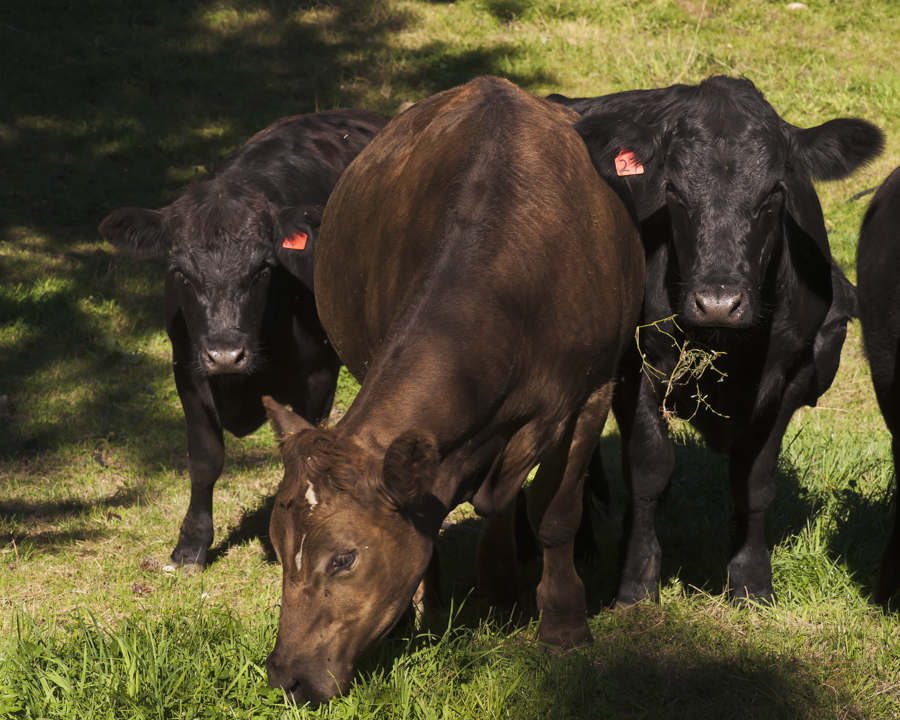
Small farms like Crown S Ranch don’t fit into the “industrial network” that has been built to handle hundreds or thousands of cattle and link huge processing plants and the ubiquitous supermarket networks. Jennifer and Louis have had to build their own processing and distribution networks.
Getting the cow to the butcher and the meat to the consumer requires some fancy footwork, particularly during the winter. It’s the supply chain – first the meat processing and then finished product delivery – that gives Louis and his wife Jennifer Argraves fits.
Selling packaged meat cuts to consumers, chefs, and retailers requires that the meat be slaughtered and “cut and wrapped” in a meat processing facility that has been licensed by the US Department of Agriculture. When the nearest facility is 190 miles away, it takes two round trips (one to deliver the live cattle and one to collect the packaged meat) plus loading and unloading time on both ends to process 6 cows at a time. Jennifer – the designated driver – is on the road 8 to 10 hours (even longer in winter) for each trip.
Supply Chain Gaps – Distribution and Delivery
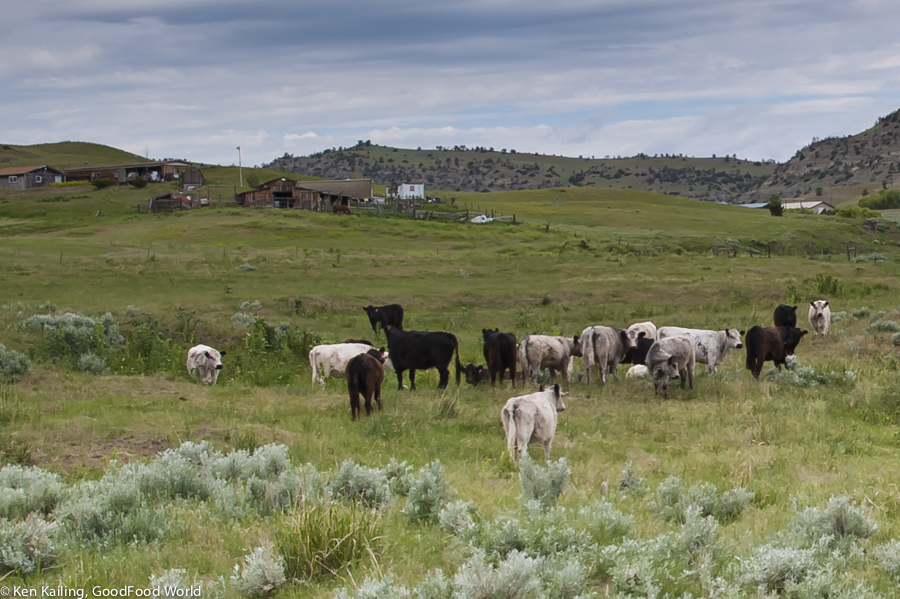
Jennifer and Louis use all sales channels available to them: direct to the consumer, buying clubs and CSAs, wholesale to food markets and restaurants, and their own farm store. Every sale and every delivery is critical to keeping the cash flowing.
Getting packaged meat into Crown S Ranch’s commercial freezers is only half the supply chain challenge that Jennifer and Louis have to deal with. Most of the farm’s orders for cut meat come from the Seattle area where customers are 225 to 240 miles away. And in winter, the hurdles get even higher.
Winter to farmers in the Northwest is just another season. You add layers, change your boots to something heavier, make sure all the animals have plenty of shelter and fresh water, and put chains on the tractor or truck. Snow is simply another element you deal with and it rarely interferes with business, school or home life.
Snow in a city like Seattle is like an invasion by a foreign army. Businesses and schools close at the hint of a flake. And when it begins to come down, those residents who must get behind the wheel do so at risk of life and limb because most drivers have only intermittent experience driving on the slippery stuff. Add the fact that most streets don’t get plowed and you have a recipe for slips, slides, bumps and crashes on nearly every thoroughfare.
Even the smallest snowfall in Puget Sound can cost Crown S Ranch a tremendous amount of time, effort, and money. While the show must go on, sometimes the meat just doesn’t get delivered. Multiple round trips – at a cost of nearly $200 per trip – and days of driving on snowy roads take their toll physically, mentally, and emotionally.
Keep the Good Food Supply Chain Connected
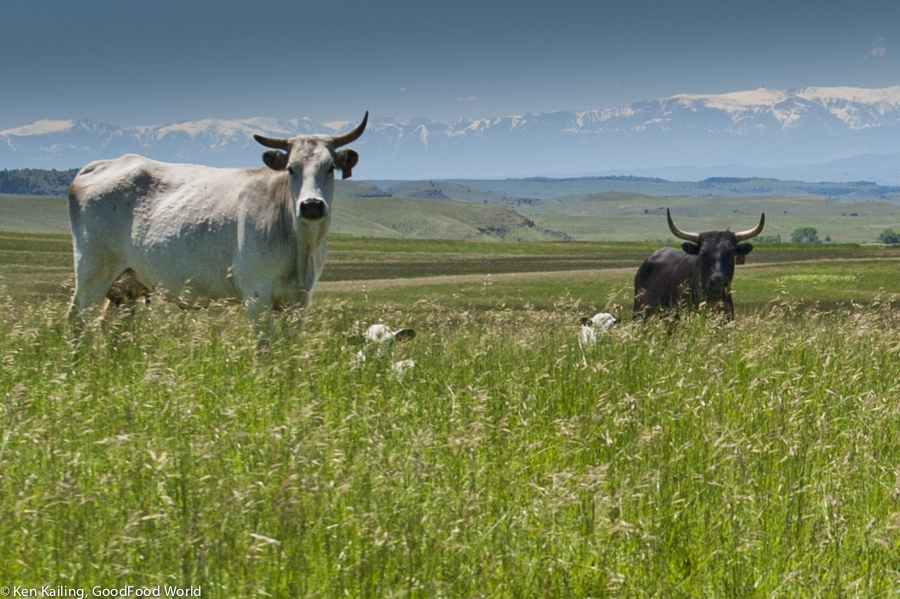
As cities continue to grow and farmland moves farther and farther away, these are challenges that small family farms, which want to maintain a direct connection to their customers, will have to manage. If we don’t find ways to resolve transportation and distribution hurdles, we are doomed to getting our food through the complex, high-energy networks maintained by the conventional food system; a system controlled by only a handful of mega-producers.
Meet your meat, get to know your farmers, and give them the support they so desperately need to keep the fragile links in the independent “good food” supply chain connected.
If you’re in Seattle, you can order meat from Crown S Ranch’s online store for delivery to multiple drop-off sites. Jennifer will make sure you get the best! And if you want to get up close and personal with your dinner, a stay in the Haycation cabin will introduce you to laying hens, broilers, pigs, turkeys, sheep and lambs, and beef cattle.
(Full disclosure: Crown S Ranch is one of a number of small producers and processors for whom I provide business and marketing services. For more information, see the GoodFood World Services offering.)
Resources:
All about Crown S Ranch:
Small Farmers Need Small Slaughter Houses
Local, Direct, Sustainable, Organic – One Farmer’s Delivery Dilemma
Holiday Roast – Grass-fed Beef
Other grass-fed beef ranchers:
Grass-fed vs. Feedlot Beef – What’s the Difference?
Grass Farming on the Bluffs Above the Mississippi River
U.S. Cattle and Beef Industry, 2002-2011, USDA Economic Research Service, http://www.ers.usda.gov/topics/animal-products/cattle-beef/statistics-information.aspx
The CAFO Reader, Daniel Imhoff, Watershed Media, 2010, P. 67
Wise Use of Antibiotics, Union of Concerned Scientists, http://www.ucsusa.org/food_and_agriculture/solutions/wise_antibiotics/pamta.html
Diet And Disease In Cattle: High-Grain Feed May Promote Illness And Harmful Bacteria, Science Daily, http://www.sciencedaily.com/releases/2001/05/010511074623.htm
Diet, Escherichia coli O157:H7, and Cattle: A Review After 10 Years, 2009, Molecular Biology, http://www.horizonpress.com/cimb/v/v11/67.pdf
Cash-strapped farmers feed candy to cows, http://money.cnn.com/2012/10/10/news/economy/farmers-cows-candy-feed/index.html
For additional information go to Eat Wild, a site maintained by Jo Robinson, author of Pasture Perfect, and source of the information on the nutritional value of grass-fed beef.

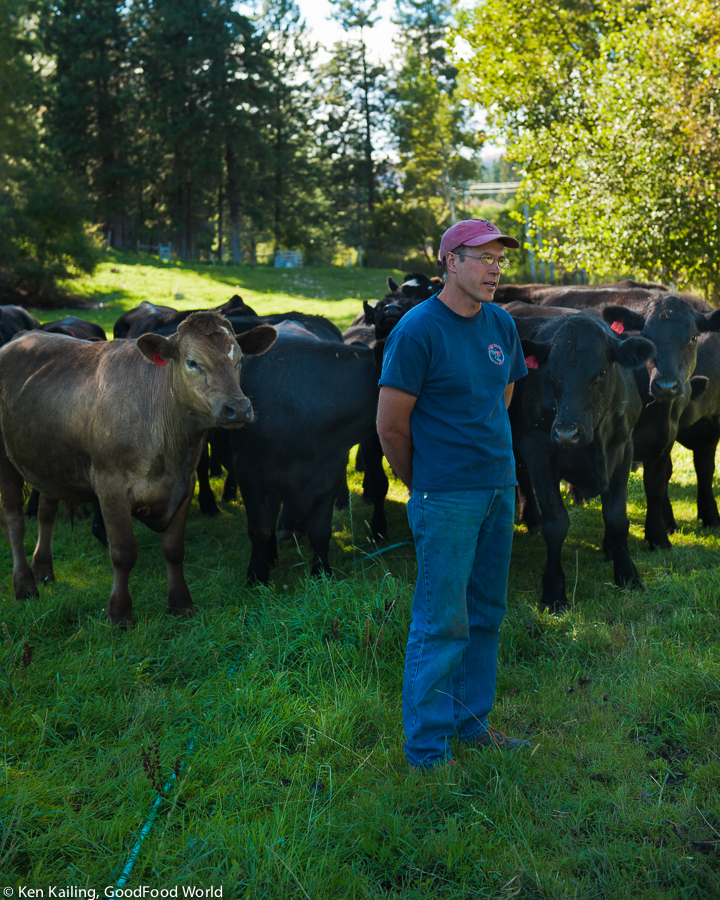
Love your blog and I agree 100%! I’m really stuck on La Cense Beef. I’ve been ordering my grass fed beef from them ever since I stopped eating grain fed beef. Do you know who they are? As a matter of fact, i just placed an order online from their new catalog.